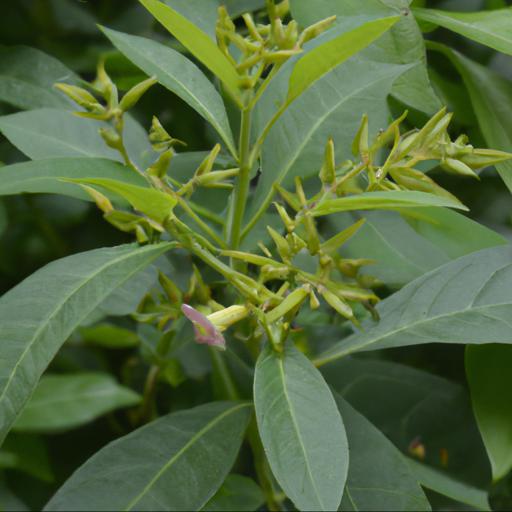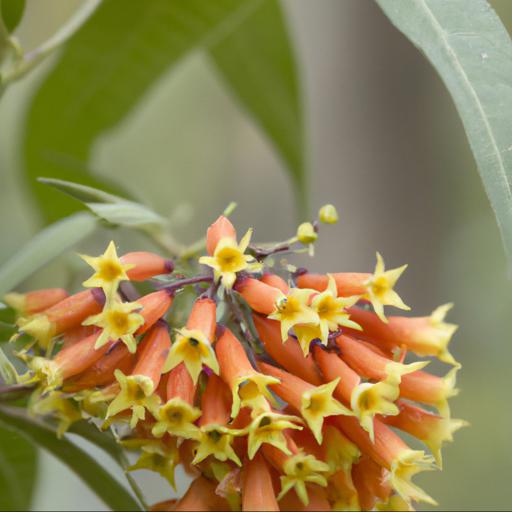Cestrum parqui, also known as the Chilean jasmine, is a flowering evergreen shrub native to South America. It is a popular ornamental plant, prized for its fragrant white flowers and glossy green foliage. The plant is easy to grow and can be used in a variety of landscaping projects.
It is also a great choice for gardeners looking for a low-maintenance, drought-tolerant shrub. Cestrum parqui has many benefits, including its ability to attract pollinators and its resistance to pests and diseases.
With its fragrant flowers and hardy nature, it is an ideal choice for any garden.
Benefits of growing cestrum parqui

As a UK garden expert, I am often asked about the benefits of growing Cestrum parqui, also known as the ‘night-scented jessamine’. This shrub is an ideal choice for an exotic-looking plant that produces intense fragrances and also helps attract beneficial pollinators. The plant’s starry white or purplish-pink flowers with yellow centres lift the garden and make it a delightful tourist attraction.
Cestrum parqui is a fast growing shrub and its evergreen foliage will ensure that the garden is lush and green year-round. Its robust growth rate means that this plant can fill in any bare spaces in the garden quickly, or provide a strong background for other plants.
In addition to having attractive foliage and flowers, it is also very easy to maintain and requires minimal trimming. The main benefit of growing Cestrum parqui is its dense, sweet-smelling flowers.
The jessamine produces highly fragrant blossoms that open in the evening, making the night-time garden a truly serene place. This potently scented shrub belongs to the nightshade family and is a very effective attractant for nocturnal butterflies, moths and hummingbirds. Because of this, many gardeners prefer to plant this shrub in a position that is easily accessible in the evening, such as near a pathway or patio.
Overall, the night-scented jessamine is an easy to grow, lovely addition to any garden. Its glossy evergreen foliage and exquisite, sweet-smelling flowers provide an ideal habitat to attract beneficial wildlife, while adding an exotic touch to the garden.
In addition to being an attractive plant, it is also an excellent resource for fragrance, colour and wildlife in the garden, making it a great choice for gardeners looking for an easy to maintain ornamental shrub.
How to plant and care for cestrum parqui

:Planting and caring for Cestrum parqui is an interesting and rewarding experience for UK gardeners – especially those with a penchant for evergreen plants. Native to South America and Central America, this plant is also known by its common name of Green Ginger or Mexican Green Bells. It produces an abundance of fragrant, delicate tubular flowers in shades of white, pink, yellow and red during the summer months, truly a treat for green-fingers and pollinators alike.
The ideal planting process for Cestrum parqui starts in the spring, so it’s a good idea to get started soon. Find a spot in your garden that gets partial to full sun, and has well-draining soil.
When you have chosen a spot, dig a hole that is twice as wide as the plant’s root ball, and just slightly deeper. Backfill the hole until its just as deep as the root ball, then gently firm the soil in the hole with your hands.
Place the plant in the centre of the hole and carefully spread the roots out, then fill with soil and cover lightly. Water thoroughly and watch your plant take off!When it comes to caring for this evergreen, be sure to keep the soil moist with regular watering, but watch out not to over-water as this will cause root rot.
Additionally, you’ll want to fertilise once a month during the growing season to ensure your plant’s continued health and growth. Since Cestrum parqui is a semi-evergreen, pruning is a must – every winter you’ll want to give it a light trim, as this helps to encourage healthy new growth in the spring. These simple tips will help keep your Cestrum parqui pristine and looking beautiful all year round, providing you with plenty of pleasure throughout the seasons.
Common pests and diseases of cestrum parqui

:Cestrum parqui, commonly known as the “purple cestrum,” is an evergreen shrub found in many landscapes and gardens in the UK. This attractive and low-maintenance shrub is very popular with gardeners due to its abundant, small, light purple flowers and easy maintenance needs. Although they’re quite easy to care for, they can be susceptible to pests and diseases and require periodic inspection.
Common pests that can target cestrum parqui include aphids, spider mites and mealybugs. Aphids are small, soft-bodied insects which can be spread from plant to plant and can cause plants to become stunted and distorted.
Spider mites are tiny, eight-legged arachnids that can cause the leaves to become yellow and distorted when webs form between the leaf surfaces. Mealybugs are small, wingless insects that can leave white, waxy deposits and a sticky secretion on the foliage. To prevent pests from attacking your cestrum parqui, be sure to regularly inspect and clean off any pests or eggs from the plant before they cause further issues.
Cestrum parqui can also be subject to a few diseases, including grey mould and powdery mildew. Grey mould is a fungal infection that causes a grey fluffy mould to form on the stems and leaves of the plant.
This can look alarming, but the plant should recover provided proper treatment is maintained. Powdery mildew is another fungal infection which produces a white powdery deposit on the leaves and can cause the leaves to curl and shrivel.
In both of these cases, fungicides and other treatments will be necessary to treat the affected plants. Overall, cestrum parqui is a fairly easy shrub to care for, but it must be monitored for any signs of pests and diseases. With regular inspections, treatments, and proper care, you can keep your cestrum parqui looking great and healthy for years to come.
Tips for growing cestrum parqui successfully
As one of the UK’s foremost garden experts, I’m here to provide a detailed guide on how to successfully cultivate and grow Cestrum parqui. This highly fragrant, evergreen shrub, often with a yellowish-green variegation, is an excellent addition to many garden designs.
To ensure your Cestrum parqui grows happy and healthy, it’s important to know various tips and tricks. First and foremost, it’s essential to provide adequate soil conditions. Cestrum parqui thrives in well-draining soil and prefers soil pH levels of
5 to 0.
If soil pH levels are far lower, wood ash or lime can be added to correct and regulate pH levels. This shrub also enjoys plenty of sun or partial shade. It’s important to note, however, that direct, harsh sunlight may scorch the leaves so you’ll need to ensure your shrub is well-protected.
Cestrum parqui is quite durable, however, like any shrub, proper hydration is necessary. This shrub prefers consistently moist (but not soggy) soil and requires weekly watering during summer. Once established, however, Cestrum parqui is remarkably drought-tolerant.
mulching is also highly recommended as it helps retain moisture in the soil and improves soil conditions over time. Be sure to cut back on watering during winter, and be cautious of frost which may badly damage the leaves.
Finally, remember to prune your Cestrum parqui occasionally. Cut back on any dead or diseased branches and trim back to maintain the desired shape. As with any other shrub, this encourages the vigorous growth of healthy branches for a fuller, thicker appearance. With these tips, your Cestrum parqui will thrive and add an extra touch of colour and fragrance to your garden!
Conclusion
Cestrum parqui, commonly known as the Peruvian cestrum, is a flowering shrub native to the Andes mountains of Peru. It is an evergreen shrub that can grow up to 6 feet tall and produces small white flowers with a pleasant scent.
The leaves are dark green and oval-shaped. The Peruvian cestrum is an attractive addition to any garden and is easy to care for. It requires full sun and well-drained soil to thrive and should be watered regularly during summer months.
Pruning is recommended to maintain the desired shape. With proper care, the Peruvian cestrum will bring beauty and fragrance to any garden.
FAQ
What is the scientific name of Cestrum parqui?
The scientific name of Cestrum parqui is Cestrum parqui L.
What are the common names of Cestrum parqui?
The common names of Cestrum parqui are “Peruvian jasmine,” “pale cestrum,” and “pale jessamine.”
What is the natural habitat of Cestrum parqui?
The natural habitat of Cestrum parqui is tropical and subtropical regions of Central and South America.
What are the characteristics of Cestrum parqui?
Cestrum parqui is an evergreen shrub with dark green, glossy leaves and fragrant white flowers. It is drought tolerant and can grow in full sun to partial shade. The shrub can reach up to 10 feet tall and can spread up to 8 feet wide. It is also known for its attractive berries that can be used in jams and jellies.
How is Cestrum parqui propagated?
Cestrum parqui is propagated by cuttings or by seed.
What are the uses of Cestrum parqui?
Cestrum parqui is a flowering shrub that is used for ornamental purposes in gardens and landscaping. It is also used medicinally to treat a variety of ailments, including fever, headaches, and stomachaches. Additionally, it is used as a natural insect repellent.

